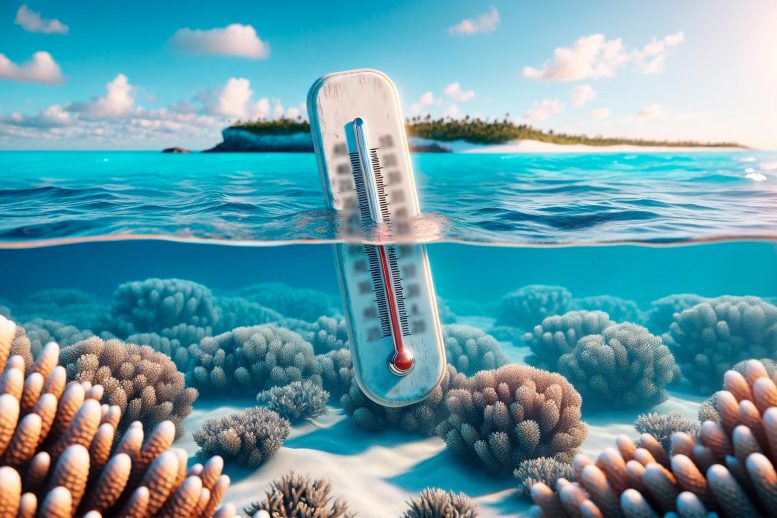
Over 40 years, the Bermuda Atlantic Time-series Study has documented significant warming, increased salinity, reduced oxygen, and higher acidity in the North Atlantic Ocean, highlighting the critical changes occurring in global marine environments. Credit: SciTechDaily.com
Data spanning 40 years shows changes in the subtropical North Atlantic Ocean near the island of Bermuda, including warming by 1°C.
Oceans are constantly changing. These changes don’t only affect marine life but also have wide-reaching consequences for land dwellers. To document them, monitoring stations in the North Atlantic Ocean have been active for decades. Now, researchers have reported on the latest changes, showing that compared to 40 years ago, the ocean near the island of Bermuda is warmer, saltier, more acidic, and has lost oxygen. Long-term monitoring can provide information about existential challenges societies will face in the near future, the researchers said.
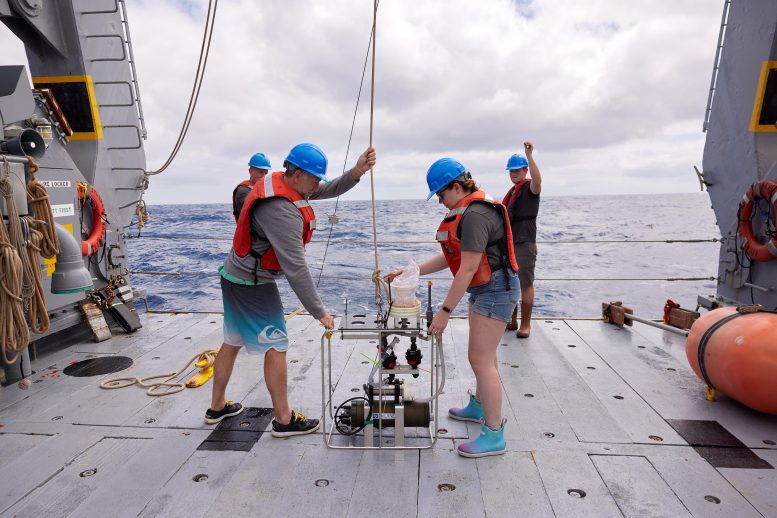
Bermuda Atlantic Time-series Study (BATS) team on BIOS’s research vessel Atlantic Explorer. Credit: Jeff Newton:
Ocean Challenges: Warming, Oxygen Decline, and Acidification
Decade-long ocean warming which impacts ocean circulation, a decrease in oxygen levels that contributes to changes in salinification and nutrient supply, and ocean acidification are just some of the challenges the world’s oceans are facing.
In 1988, a comprehensive sustained ocean time-series of observations, called the Bermuda Atlantic Time-series Study (BATS), began at a site about 80 km southeast of the island of Bermuda. There, scientists take monthly samples of the physics, biology, and chemistry of the ocean’s surface and depths. In a new paper published in Frontiers in Marine Science, researchers have now presented the latest findings from this monitoring effort.
“We show that the surface ocean in the subtropical North Atlantic Ocean has warmed by around 1°C over the past 40 years. Furthermore, the salinity of the ocean has increased, and it has lost oxygen,” said author Prof Nicholas Bates, an ocean researcher at the Bermuda Institute of Ocean Sciences, a unit of the Julie Ann Wrigley Global Futures Laboratory at Arizona State University (ASU) and professor in the School of Ocean Futures at ASU. “In addition, ocean acidity has increased from the 1980s to the 2020s.”
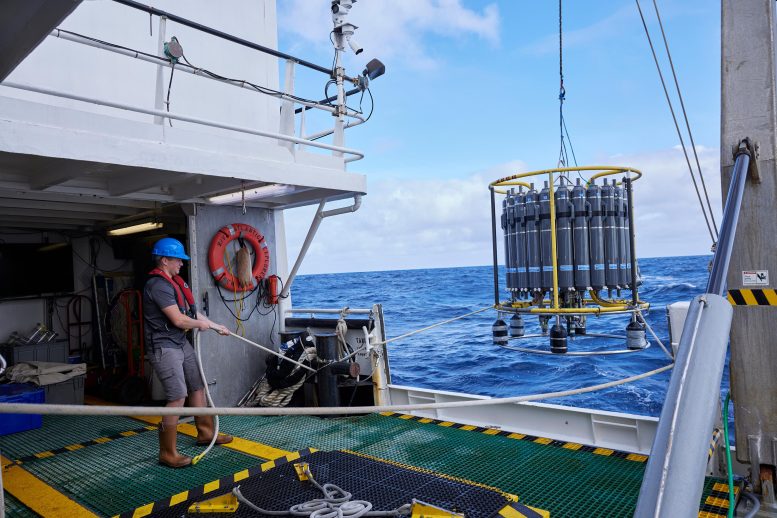
Bermuda Atlantic Time-series Study (BATS) team on BIOS’s research vessel Atlantic Explorer. Credit: Jeff Newton
Warm, Salty, Deoxidized, Acidic
At the BATS monitoring station, ocean surface temperatures have increased by around 0.24°C each decade since the 1980s. Added up, the ocean is around 1°C warmer now than it was 40 years ago. In the last four years, ocean temperatures have also risen more sharply than in the previous decades, the researchers found.
Not only have the monitored waters gotten warmer, but also more saline at the surface, meaning more salt is dissolved in the water. Like surface temperature, this saltiness has disproportionally increased during the last few years, the newest data showed. “We suspect this is part of the broader, more recent trends and changes in ocean temperatures and environmental changes, like atmospheric warming and having had the warmest years globally,” Bates said.
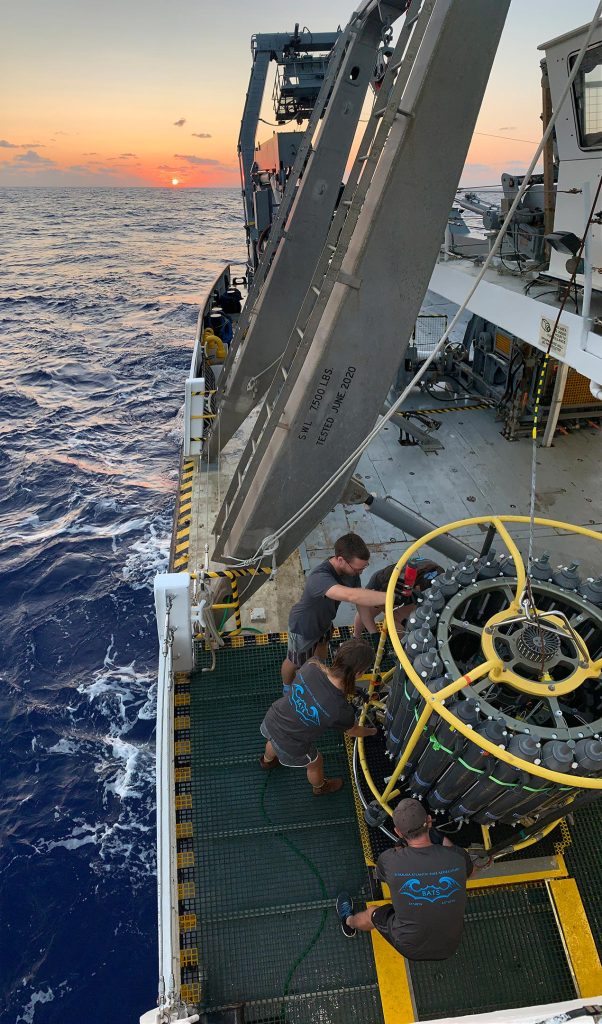
Bermuda Atlantic Time-series Study (BATS) team on BIOS’s research vessel Atlantic Explorer. Credit: BATS
At the same time, the data indicated that over the last 40 years the amount of oxygen available to living aquatic organisms has decreased by 6%. Acidity values, too, have changed: the ocean is now 30% more acidic than it was in the 1980s, resulting in lower carbon ion concentrations. This can, among other things, affect shelled organisms’ ability to sustain their shells.
“The ocean chemistry of surface waters in the 2020s is now outside of the seasonal range observed in the 1980s and the ocean ecosystem now lives in a different chemical environment to that experienced a few decades ago,” Bates explained. “These changes are due to the uptake of anthropogenic CO2 from the atmosphere.”
The Importance of Long-Term Data
Collecting data over extended time periods is important to predict upcoming shifts in conditions. “These observations give a sense of the rate of change in the recent past of ocean warming and ocean chemistry. They provide key indications of future changes in the next decades,” said Bates. “They also are proof of regional and global environmental change and the existential challenges we face as individuals and societies in the near future.”
The monitoring stations providing the data for the present study are just two out of the several long-term sustained ocean time-series sites located throughout the world’s oceans. Stations off Hawaii, the Canary Islands, Iceland, and New Zealand are also key to monitoring long-term oceanic changes. At some of those stations, similar processes have been observed, highlighting the challenges and complexities of understanding the long-term interactions between warming, salinification, and ocean acidification, the researchers said.
Reference: “Forty years of ocean acidification observations (1983–2023) in the Sargasso Sea at the Bermuda Atlantic Time-series Study site” by Nicholas R. Bates and Rodney J. Johnson, 25 October 2023, Frontiers in Marine Science.
DOI: 10.3389/fmars.2023.1289931

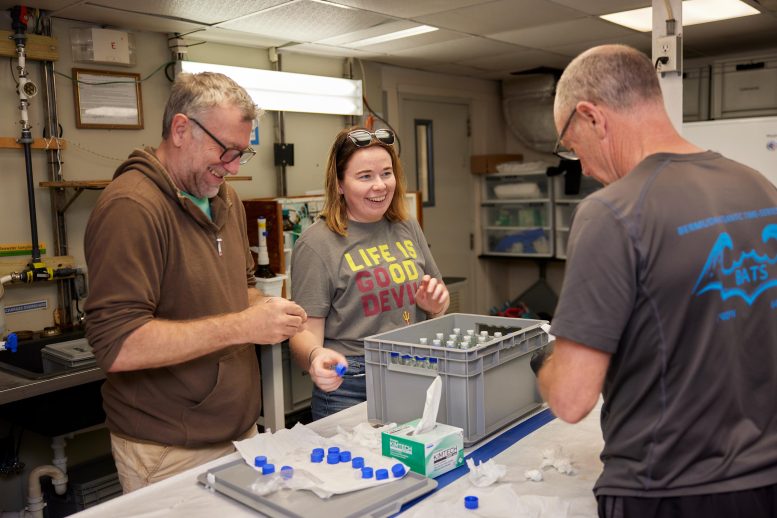



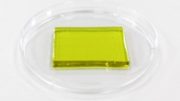




That’s interesting. I’m glad they’re taking measurements. Odd they found fewer carbon ions while claiming higher CO2 uptake, but they probably meant carbonate ions. Higher salinity makels sense with more water mixing, considering the halocline.
A climate is approximately 30 years. Based on 40 years of data, they can approximate a climate, but they can’t show a change of that climate. Until maybe another couple more decades of measurements, they are claiming the weather has changed. Yes it has. Claiming climate change, and also attributing a cause, is premature.
The article conflates the temperature of the oceans with the temperature of the surface of the ocean water. This may seem pedantic, and maybe it is, but if your skin surface temperature changes five degrees, you might not notice, but if your core temperature does, you’ve probably died. They’re not really scratching the surface.
“Acidity values, too, have changed: the ocean is now 30% more acidic than it was in the 1980s, …”
This often repeated claim is misleading. First off, grammatically, one cannot have more of something that doesn’t exist. The oceans are, and probably always will be, alkaline. The point is, something can’t be “more acidic” if is wasn’t acidic before a change took place.
From something I have written previously:
“A pH decline from 8.2 to 8.1, the commonly claimed recent change in seawater, … amounts to a change of -1.2% on the pH scale (-0.1/8.2) and it would take a change of about -15% to reach neutrality (pH = 7). It is disingenuous to cite an equivalent change of 30% in the untransformed active hydrogen ion concentration … without noting the percentage change required to reach even neutrality, let alone an actual significant acid condition. The alleged change that has occurred in hydrogen ion concentration is actually about 25% (The value usually cited is rounded up considerably!). It would take a change of nearly 1500% in the hydrogen ion concentration to reach neutrality. That is, there has been a percentage change of about 1.7% (25/1500) of hydrogen ion concentration necessary to reach neutrality. Inflating numbers and not putting them in context seems to me to be an act of hyperbole that raises a question of objectivity.” http://wattsupwiththat.com/2015/09/15/are-the-oceans-becoming-more-acidic/
I spoke to a colleague from Bermuda about this article. As Bermuda is essentially a large rock in the Atlantic, there isn’t fresh groundwater, so apparently the water supply comes from desalinization. Effluent from the process is a hot hypersaline brine with a acidic pH below 5 (“Desalination technology waste streams: Effect of pH and salinity on metabolism of marine microbial assemblages”, Desalination journal, Dec 2009).
While the Atlantic ocean is enormous, and the overall effects of desalination plants should be negligable on it, industrial-scale discharge of hot salty acid into the ocean would likely move the needle on temperature & salinity & pH measurements taken of surface water from only a couple dozen kilometers away.
I’m not criticizing Bermuda for using desalination. They must, and I would too. It seems buildings there are even required to collect rainwater by law.
Beautiful image accompanying the story! Who drew it?
That’s an artificial intelligence photo. By making photos with AI this year, SciTechDaily doesn’t have to license photography, saving money. If you search online for how to make these photos, you can make these for free. I’m a critic of their bad AI art, but that photo is pretty, and it is reasonably Bermuda-ish.
Before someone argues it’s only in a style reminescent of an AI photo, note please the thermometer’s temperature scale. It’s been intentionally blurred out, because it very clearly goes “20 40 30 40 20…25 20 22 40 40” for fahrenheit, and celcius is “20 A 30 12 34 28 40 32 30 30 20 10” with a random number of increment lines in each section. AI makes mistakes, with no intelligence interpreting the purpose of the markings on the sides of a thermometer, only that there are number or letter markings. It sounds like I’m being a critic again, but I like when art looks neat, and I appreciate scitechdaily blurring out the silly bits, though we are all missing out on having a good laugh had it been left unblurred.
I appreciate your criticism.